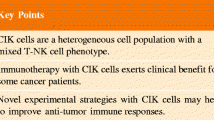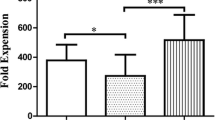Summary
It has been proposed that a component of the antitumor potential of the chemotherapeutic agent, cisplatin, resides in the host's ability to respond to cisplatintreated tumor cells. Here we report that tumor cells that are normally resistant to lysis mediated by naturally occurring cytotoxic cells showed an increased sensitivity to lysis mediated by murine spleen cells or human peripheral blood monocytes and lymphocytes when cisplatin was added at the beginning of the lytic assay. This was shown for the lysis of both murine and human tumor cells. The pretreatment of tumor cells, but not effector cells with cisplatin caused an increase in lysis in the presence of murine spleen cells or human peripheral blood leukocytes, indicating that the effect of cisplatin is to reduce resistance to lysis by these effector cells. The lysis of tumor cells by naturally occurring cytotoxic cells was blocked by antibodies specific for tumor necrosis factor. In addition, the ability of cisplatin to increase lysis was seen with cells that are sensitive to natural cytotoxic cells, but not with cells that are sensitive to natural killer cells. These results suggest that the effector cells that mediate the lysis of these tumor cells in the presence of cisplatin are likely to be natural cytotoxic cells. The ability of cisplatin to increase the lysis of tumor cells by naturally occurring cytotoxic cells indicates that these cells may be a host defense mechanism that contributes to the anticancer potential of cisplatin.
Similar content being viewed by others
References
Alberts DS, Chen HSB (1980) Tabular summary of pharmacokinetic parameters relevant to in vitro drug assay. In: Cloning of human tumor cells. Alan Liss Inc, New York, p 3518
Bagasra O, Currao L, DeSouza LR, Oosterhuis JW, Damjanov (1985) Immune response of mice exposed to cis-diamminedichloroplatinum. Cancer Immunol Immunother 19:142
Chary KK, Higby DJ, Henderson ES, Swinerton KD (1977) Phase I study of high dose cis-dichlorodiammineplatinum (II) with forced diuresis. Cancer Treat Rep 61:367
Collins JL, Patek PQ, Cohn M (1981) Tumorigenicity and lysis by natural killers. J Exp Med 153:89
Collins JL, Patek PQ, Cohn M (1982) In vivo surveillance of tumorigenic cells transformed in vitro. Nature 299:169
Collins JL, Patek PQ, Lin Y, Cohn M (1983) The cloned cell line L10A2. J expresses natural cytotoxic activity. Cell Immunol 103:191
Collins JL, Lin Y, Patek PQ (1986) Dissociation of contactnoninhibition in vitro and tumorigenicity in vivo. Cell Biol Int Rep 10:789
Collins JL, Kao M-S, Patek PQ (1987) Humans express natural cytotoxic (NC) cell activity that is similar to murine NC cell activity. J Immunol 138:4180
Epstein R, Cohn M (1978) T-cell inhibition of humoral responsiveness. I. Experimental evidence for restriction by K- and/or D-end of the H-2 complex. Cell Immunol 39:110
Gottlieb JA, Drewink OB (1975) Review of the current clinical status of platinum coordination complexes in cancer chemotherapy. Cancer Chemother Rep 59:621
Higby DJ, Wallace HJ, Albert DJ, Holland JF (1974) Diaminodichloroplatinum: a phase I study showing responses in testicular and other tumors. Cancer 33:1219
Hill JM, Loeb E, MacLellan A, Hill NO, Khan A, King JJ (1975) Clinical studies of platinum coordination compounds in the treatment of various malignant diseases. Cancer Chemother Rep 59:647
Kiessling R, Klein E, Wigzell H (1975) ‘Natural’ killer cells in the mouse. I. Cytotoxic cells with specificity for mouse Moloney leukemia cells. Specificity and distribution according to genotype. Clin Immunol 5:112
Kleinerman ES, Zwelling LA (1984) Effects of cisplatin, bleomycin and DTIC on immune function in vitro and in vivo. Clin Immunol Allergy 4:279
Kociba RJ, Sleight SD, Rosenberg B (1970) Inhibition of Dunning ascitic leukemia and Walker 256 carcinosarcoma with cis-diamminedichloroplatinum (NSC-119875). Cancer Chemother Rep 54:325
Lin Y, Collins JL, Patek PQ, Cohn M (1983) An analysis of the sensitivity of somatic cell hybrids to natural killer and natural cytotoxic cell-mediated lysis. J Immunol 131:1154
Lozzio CB, Lozzio BB (1975) Human myelogenous leukemia cell line with positive Philadelphia chromosome. Blood 45:321
Patek PQ, Collins JL, Cohn M (1978) Transformed cell lines susceptible or resistant to in vivo surveillance against tumorigenesis. Nature 276:510
Patek PQ, Collins JL, Cohn M (1983) Evidence that cytotoxic T-cells and natural cytotoxic cells use different lytic mechanisms to lyse the same targets. Eur J Immunol 13:433
Patek PQ, Lin Y, Collins JL, Cohn M (1986) In vivo or in vitro selection for resistance to natural cytotoxic cell lysis selects for variants with increased tumorigenicity. J Immunol 136:741
Patek PQ, Lin Y, Collins JL (1987) Natural cytotoxic cells and tumor necrosis factor activate similar lytic mechanisms. J Immunol 138:1641
Rosenberg B (1980) Enhanced antigenicity as a possible mode of action of platinum antitumor drugs. In: Advances in antimicrobial and antineoplastic chemotherapy, vol II. University Park Press, Baltimore, p 101
Rosenberg B (1980) Cisplatin: its history and possible mechanism of action. In: Cisplatin: current status and new developments. Academic Press, New York, p 9
Rosenberg B, VanCamp L (1970) The successful regression of large solid sarcoma 180 tumors by platinum compounds. Cancer Res 30:1799
Rosenberg B, VanCamp L, Trosko J, Mansour VH (1969) Platinum compounds: a new class of potent antitumor agents. Nature 222:385
Schlaefli E, Ehrke MJ, Mihich E (1983) The effects of dichloro-trans-dihydroxy-bis-isopropylamine-platinum IV on the primary cell mediated cytotoxic response. Immunopharmacology 6:107
Scovell WM, O'Connor T (1977) Interaction of aquated cis-[(NH3)2PtII] with nucleic acid constituents. J Am Chem Soc 99:120
Stutman O, Cuttito MJ (1981) Normal levels of natural cytotoxic cells against solid tumors in NK deficient beige mice. Nature 290:254
Talley RW (1970) Chemotherapy of a mouse reticulum cell sarcoma with platinum salts. Proc Am Assoc Cancer Res 11:78
Timonen T, Ortaldo JR, Herberman RB (1981) Characteristics of human large granular lymphocytes and relationship to natural killer and K cells. J Exp Med 153:569
Vonka V, Kutinova L, Drobnik J, Brauerova J (1972) Increase of Epstein-Bar-virus-positive cells in EB3 cultures after treatment with cis-dichlorodiammine-platinum (II). J Natl Cancer Inst 48:1277
Welsch CW (1971) Growth inhibition of rat mammary carcinoma induced by cis-platinum diamminodichloride II. J Natl Cancer Inst 47:1071
Wright KC, Carrasco CH, Wallace S, Stephens LC (1985) Treatment of the rabbit V-2 carcinoma with intralesional cisplatin. Chemother 31:60
Author information
Authors and Affiliations
Rights and permissions
About this article
Cite this article
Collins, J.L., Kao, MS. The anticancer drug, cisplatin, increases the naturally occurring cell-mediated lysis of tumor cells. Cancer Immunol Immunother 29, 17–22 (1989). https://doi.org/10.1007/BF00199911
Received:
Accepted:
Issue Date:
DOI: https://doi.org/10.1007/BF00199911




